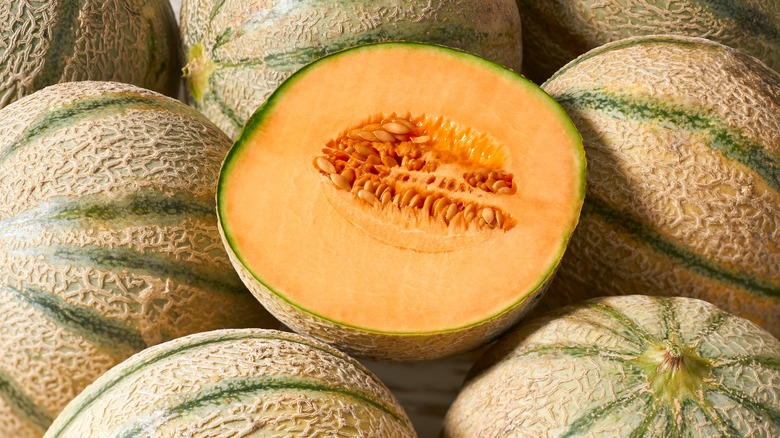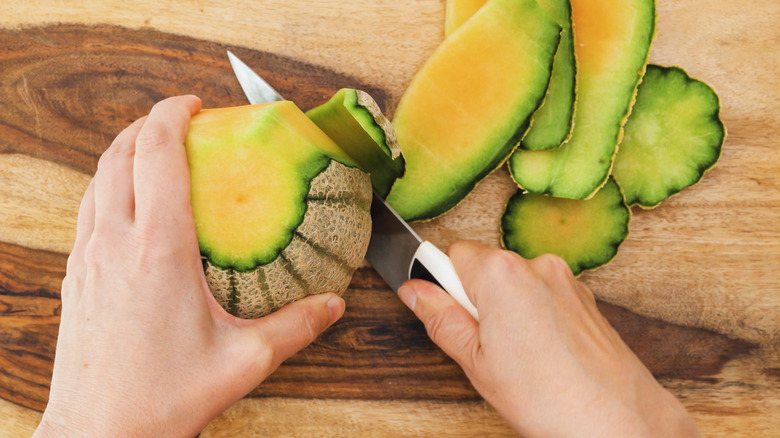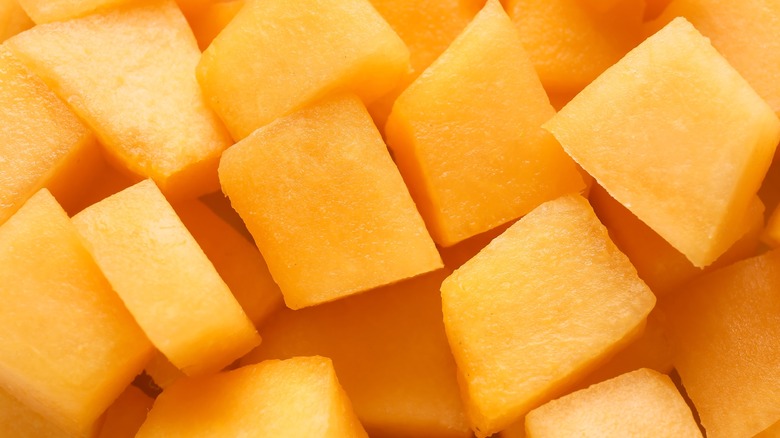The Best Way To Store Cantaloupe
Storing cantaloupe properly is the difference between honeyed, floral, juicy fruit that you can enjoy for days, versus a spoiled, mushy mess. For starters, you may be tempted to cut and portion the melon immediately after taking it home, but unless you're planning on eating it very soon after, you're better off keeping it whole. A whole fruit will stay fresher for longer than one that's been cut open.
Cantaloupes like to be kept between 36 and 40 degrees Fahrenheit, and which is also the temperature range your refrigerator should be set at. When refrigerated, whole, ripe melons will stay fresh for up to two weeks, depending on when they were harvested and how long they sat in the store. A fruit that has been picked recently will last about that long, but a standard grocery store cantaloupe — given the time it takes to go through the supply chain — will probably only keep for less than a week. If you just don't have fridge space, the countertop will do just fine for about four days at most.
For long-lasting and delicious fruit, you'll want to learn how to choose the tastiest cantaloupe at the store. Look for yellowish, heavy fruits that are free of soft spots. A good ripeness test is to find the indentation where the stem used to be and press the flesh near it. The fruit should have just a little give; if it's mushy or rock-hard, put the melon back.
How to store cantaloupe in the refrigerator
Just because you don't eat cantaloupe skin doesn't mean you can skip washing it. You should never cut into an unwashed melon, because contaminants from the outside will be drawn into the inner fruit via the knife. To prolong the shelf-life, don't wash the melon until you're ready to serve it. Rinse the fruit under running water and scrub it with a produce-cleaning brush, since the raised skin with a net-like pattern easily traps bacteria.
Cutting cantaloupe is easy, but the flesh is slippery, so keep your cutting board from slipping with this towel trick. Halve the fruit vertically from pole to pole, then easily cut it into wedges. If you plan to store some of the slices for later, leaving the squash-like seeds intact can keep the fruit fresh for longer. Wrap the wedges in plastic wrap, put them in resealable baggies or an airtight container, and enjoy within three days.
Cubes of cantaloupe, meanwhile, last just a day or two in the fridge. To portion the fruit in this way, carefully run the point of your knife along the rind of each wedge to separate the fruit from the skin, then cut into chunks. You can also cut off each end, stand the fruit upright, and peel off the skin before cubing the flesh. Store the pieces in an airtight container lined with a paper towel, so that the cantaloupe doesn't soak in its own juice.
How to store cantaloupe in the freezer
Since cut cantaloupe has a relatively short shelf life, it is a great idea to take advantage of your freezer. Just keep in mind that once defrosted, fruits have a tendency to get mushy, so it is always better to use them in their frozen state or blended up so you don't notice the change in texture. This doesn't have to be a bad thing — frozen cantaloupe is excellent to have on hand for all your favorite smoothies, cocktails, and even fruit-based sauces and desserts.
Cubed cantaloupe is the most convenient form to freeze. Some guides recommend tossing the melon with a little bit of sugar or simple syrup first to help retain its color and flavor. Lay out the chunks in a single layer on a sheet tray covered in a silicone liner or parchment paper, then freeze. Once frozen, transfer the pieces to an airtight container or a resealable plastic bag; the extra sheet pan step prevents the fruit from freezing into a solid block. Whether you're freezing or refrigerating cantaloupe, it is always a good idea to mark the container with the date that you stashed it, so you can keep an eye on its freshness. Frozen cantaloupe will stay fresh and tasty for about six months.



